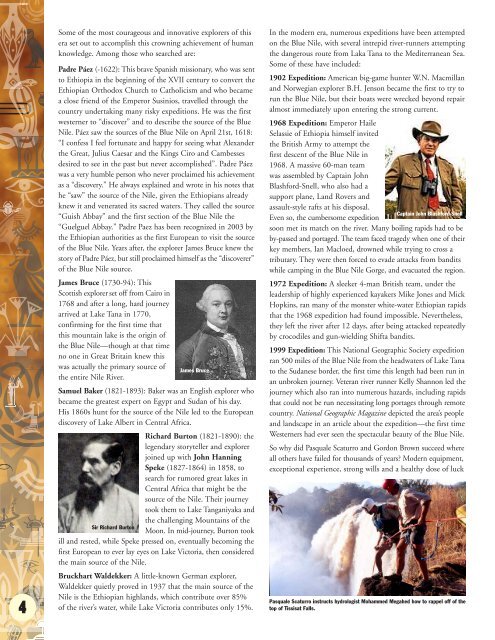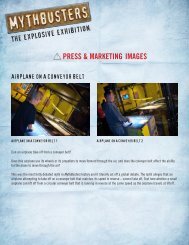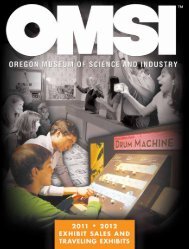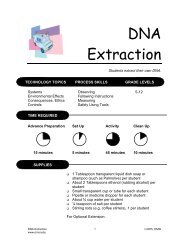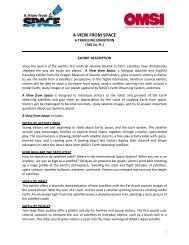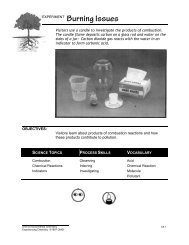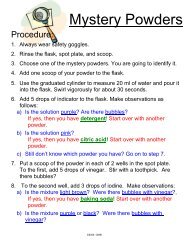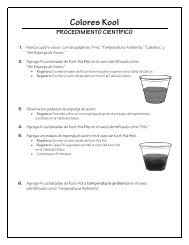You also want an ePaper? Increase the reach of your titles
YUMPU automatically turns print PDFs into web optimized ePapers that Google loves.
4<br />
Some <strong>of</strong> <strong>the</strong> most courageous and innovative explorers <strong>of</strong> this<br />
era set out to accomplish this crowning achievement <strong>of</strong> human<br />
knowledge. Among those who searched are:<br />
Padre Páez (-1622): This brave Spanish missionary, who was sent<br />
to Ethiopia in <strong>the</strong> beginning <strong>of</strong> <strong>the</strong> XVII century to convert <strong>the</strong><br />
Ethiopian Orthodox Church to Catholicism and who became<br />
a close friend <strong>of</strong> <strong>the</strong> Emperor Susinios, travelled through <strong>the</strong><br />
country undertaking many risky expeditions. He was <strong>the</strong> first<br />
westerner to “discover” and to describe <strong>the</strong> source <strong>of</strong> <strong>the</strong> Blue<br />
<strong>Nile</strong>. Páez saw <strong>the</strong> sources <strong>of</strong> <strong>the</strong> Blue <strong>Nile</strong> on April 21st, 1618:<br />
“I confess I feel fortunate and happy for seeing what Alexander<br />
<strong>the</strong> Great, Julius Caesar and <strong>the</strong> Kings Ciro and Cambesses<br />
desired to see in <strong>the</strong> past but never accomplished”. Padre Páez<br />
was a very humble person who never proclaimed his achievement<br />
as a “discovery.” He always explained and wrote in his notes that<br />
he “saw” <strong>the</strong> source <strong>of</strong> <strong>the</strong> <strong>Nile</strong>, given <strong>the</strong> Ethiopians already<br />
knew it and venerated its sacred waters. They called <strong>the</strong> source<br />
“Guish Abbay” and <strong>the</strong> first section <strong>of</strong> <strong>the</strong> Blue <strong>Nile</strong> <strong>the</strong><br />
“Guelguel Abbay.” Padre Paez has been recognized in 2003 by<br />
<strong>the</strong> Ethiopian authorities as <strong>the</strong> first European to visit <strong>the</strong> source<br />
<strong>of</strong> <strong>the</strong> Blue <strong>Nile</strong>. Years after, <strong>the</strong> explorer James Bruce knew <strong>the</strong><br />
story <strong>of</strong> Padre Páez, but still proclaimed himself as <strong>the</strong> “discoverer”<br />
<strong>of</strong> <strong>the</strong> Blue <strong>Nile</strong> source.<br />
James Bruce (1730-94): This<br />
Scottish explorer set <strong>of</strong>f from Cairo in<br />
1768 and after a long, hard journey<br />
arrived at Lake Tana in 1770,<br />
confirming for <strong>the</strong> first time that<br />
this mountain lake is <strong>the</strong> origin <strong>of</strong><br />
<strong>the</strong> Blue <strong>Nile</strong>—though at that time<br />
no one in Great Britain knew this<br />
was actually <strong>the</strong> primary source <strong>of</strong><br />
James Bruce<br />
<strong>the</strong> entire <strong>Nile</strong> River.<br />
Samuel Baker (1821-1893): Baker was an English explorer who<br />
became <strong>the</strong> greatest expert on Egypt and Sudan <strong>of</strong> his day.<br />
His 1860s hunt for <strong>the</strong> source <strong>of</strong> <strong>the</strong> <strong>Nile</strong> led to <strong>the</strong> European<br />
discovery <strong>of</strong> Lake Albert in Central Africa.<br />
Richard Burton (1821-1890): <strong>the</strong><br />
legendary storyteller and explorer<br />
joined up with John Hanning<br />
Speke (1827-1864) in 1858, to<br />
search for rumored great lakes in<br />
Central Africa that might be <strong>the</strong><br />
source <strong>of</strong> <strong>the</strong> <strong>Nile</strong>. Their journey<br />
took <strong>the</strong>m to Lake Tanganiyaka and<br />
<strong>the</strong> challenging Mountains <strong>of</strong> <strong>the</strong><br />
Sir Richard Burton<br />
Moon. In mid-journey, Burton took<br />
ill and rested, while Speke pressed on, eventually becoming <strong>the</strong><br />
first European to ever lay eyes on Lake Victoria, <strong>the</strong>n considered<br />
<strong>the</strong> main source <strong>of</strong> <strong>the</strong> <strong>Nile</strong>.<br />
Bruckhart Waldekker: A little-known German explorer,<br />
Waldekker quietly proved in 1937 that <strong>the</strong> main source <strong>of</strong> <strong>the</strong><br />
<strong>Nile</strong> is <strong>the</strong> Ethiopian highlands, which contribute over 85%<br />
<strong>of</strong> <strong>the</strong> river’s water, while Lake Victoria contributes only 15%.<br />
In <strong>the</strong> modern era, numerous expeditions have been attempted<br />
on <strong>the</strong> Blue <strong>Nile</strong>, with several intrepid river-runners attempting<br />
<strong>the</strong> dangerous route from Laka Tana to <strong>the</strong> Mediterranean Sea.<br />
Some <strong>of</strong> <strong>the</strong>se have included:<br />
1902 Expedition: American big-game hunter W.N. Macmillan<br />
and Norwegian explorer B.H. Jenson became <strong>the</strong> first to try to<br />
run <strong>the</strong> Blue <strong>Nile</strong>, but <strong>the</strong>ir boats were wrecked beyond repair<br />
almost immediately upon entering <strong>the</strong> strong current.<br />
1968 Expedition: Emperor Haile<br />
Selassie <strong>of</strong> Ethiopia himself invited<br />
<strong>the</strong> British Army to attempt <strong>the</strong><br />
first descent <strong>of</strong> <strong>the</strong> Blue <strong>Nile</strong> in<br />
1968. A massive 60-man team<br />
was assembled by Captain John<br />
Blashford-Snell, who also had a<br />
support plane, Land Rovers and<br />
assault-style rafts at his disposal.<br />
Captain John Blashford-Snell<br />
Even so, <strong>the</strong> cumbersome expedition<br />
soon met its match on <strong>the</strong> river. Many boiling rapids had to be<br />
by-passed and portaged. The team faced tragedy when one <strong>of</strong> <strong>the</strong>ir<br />
key members, Ian Macloed, drowned while trying to cross a<br />
tributary. They were <strong>the</strong>n forced to evade attacks from bandits<br />
while camping in <strong>the</strong> Blue <strong>Nile</strong> Gorge, and evacuated <strong>the</strong> region.<br />
1972 Expedition: A sleeker 4-man British team, under <strong>the</strong><br />
leadership <strong>of</strong> highly experienced kayakers Mike Jones and Mick<br />
Hopkins, ran many <strong>of</strong> <strong>the</strong> monster white-water Ethiopian rapids<br />
that <strong>the</strong> 1968 expedition had found impossible. Never<strong>the</strong>less,<br />
<strong>the</strong>y left <strong>the</strong> river after 12 days, after being attacked repeatedly<br />
by crocodiles and gun-wielding Shifta bandits.<br />
1999 Expedition: This National Geographic Society expedition<br />
ran 500 miles <strong>of</strong> <strong>the</strong> Blue <strong>Nile</strong> from <strong>the</strong> headwaters <strong>of</strong> Lake Tana<br />
to <strong>the</strong> Sudanese border, <strong>the</strong> first time this length had been run in<br />
an unbroken journey. Veteran river runner Kelly Shannon led <strong>the</strong><br />
journey which also ran into numerous hazards, including rapids<br />
that could not be run necessitating long portages through remote<br />
country. National Geographic Magazine depicted <strong>the</strong> area’s people<br />
and landscape in an article about <strong>the</strong> expedition—<strong>the</strong> first time<br />
Westerners had ever seen <strong>the</strong> spectacular beauty <strong>of</strong> <strong>the</strong> Blue <strong>Nile</strong>.<br />
So why did Pasquale Scaturro and Gordon Brown succeed where<br />
all o<strong>the</strong>rs have failed for thousands <strong>of</strong> years? Modern equipment,<br />
exceptional experience, strong wills and a healthy dose <strong>of</strong> luck<br />
Pasquale Scaturro instructs hydrologist Mohammed Megahed how to rappel <strong>of</strong>f <strong>of</strong> <strong>the</strong><br />
top <strong>of</strong> Tissisat Falls.


